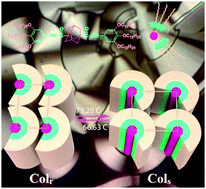Generation of liquid crystallinity from a Td-symmetry central unit†
Abstract
A series of new columnar liquid crystals containing an adamantane central unit with its four bridgehead positions partially or fully decorated with different numbers (1–4) of 3,4,5-tris(dodecyloxy)phenyl carbamoyl groups were designed and investigated carefully to explore the structure–property correlations. The molecular structures and mesomorphic properties of the DLCs were characterized by 1H-NMR, 13C-NMR, IR, UV-vis, POM, DSC and XRD. It was found that the mesophase symmetry and thermal stability were extremely dependent on the structures of the adamantane derivatives. No mesophase was observed for the 1-adamantanecarboxylic acid derivative ADLC1, while two different mesophases were observed for ADLC2, a 1,3-disubstituted derivative functionalized with two 3,4,5-tris(dodecyloxy)phenyl carbamoyl groups at two symmetric bridgehead positions. At lower temperature ADLC2 exhibited a rectangular columnar phase, which switched to a square columnar phase possessing a wide temperature range. Similarly, a hexagonal columnar mesophase was observed for the bridgehead trisubstituted adamantane molecule ADLC3. Interestingly, the fully bridgehead-functionalized 1,3,5,7-tetrasubstituted adamantane compound ADLC4 completely lost liquid crystallinity.


 Please wait while we load your content...
Please wait while we load your content...